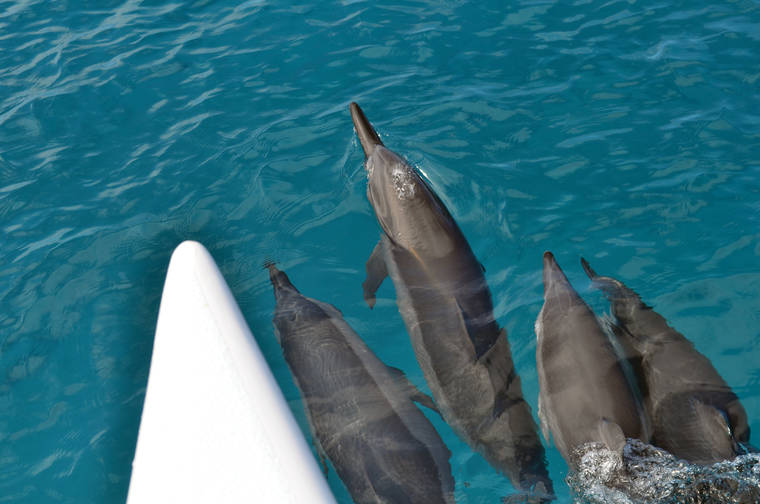KAILUA-KONA — Federal officials are still working to finalize a rule three years in the making that’ll render it illegal to approach or swim with spinner dolphins in Hawaii.
“We’re hoping to finish it soon,” said Ann Garrett, assistant regional administrator for the National Oceanic and Atmospheric Administration National Marine Fisheries Service Pacific Islands Regional Office Protected Resources Division in Honolulu.
“I don’t have a deadline to tell you or a date that I can say, but I would hope that you will see something within the next six to nine months.”
If implemented, the rule would create a 50-yard barrier around spinner dolphins, “naia” in Hawaiian, for swimmers, vessels (including stand-up paddleboards) and objects (such as drones) within two nautical miles of the shore. That means being within 1/2 of a football field of a spinner dolphin, by any means, including swimming or intercepting by boat, the mammal’s path, would be outlawed — statewide.
“The issue here particularly on the Big Island, but also on Oahu and to a lesser-degree on some of the other islands, is that repeated interactions with some of these animals with humans can actually change their behavior, and changing their ecology can be problematic,” Garrett said. “Potentially, it can even decrease their chances of survival.”
Tour boat captains on Kauai refer to the regular practice of dolphins surrounding boats as “mugging,” and have to stop their engines to avoid contact.
The under-review regulation, which would ban a practice that has created a booming tourism industry in West Hawaii and around the state, was proposed in August 2016 by NOAA following about a decade of discussion. The final rule will go into effect 30 days after publishing it and a final environmental impact statement in the Federal Register, unless otherwise noted.
“We hope and we expect when this rule is finalized to come out and do a huge campaign to educate people about it and what it means for their business,” said Garrett.
”We’ve seen firsthand through our Dolphin SMART program that they can have viable businesses offering solid ecotourism-type tours,” said Garrett, “and people can have enjoyable experiences without being that close and without those sort of aggressive behaviors on those dolphins.”
Garrett provided the update among other information during a presentation last week at the Kailua-Kona Public Library. Joining her was the division’s wildlife management coordinator, Adam Kurtz.
Enforcement of the rule, if implemented, will fall to the state Department of Land and Natural Resources Division of Conservation and Resources Enforcement and the law enforcement arm of NOAA, Garrett said.
Attendees such as former Kona Councilman Keola Childs questioned whether the agencies will have enough people, much less the time to spend in West Hawaii.
“I’m just doubting this will actually work,” he said. “DOCARE has very few people. And I’m sure your agency has even fewer and they’re not going to be sitting around in Kailua. So, how can we make it work?”
Garrett said both agencies have been expanding ranks, and noted the importance of education and outreach as well. Further, the public will play a vital role.
“We have been growing social media awareness so people are taking pictures and sending them to us and we are using those as tools to prosecute,” Garrett said. “We have prosecuted a few of these guys because we can see that behavior and what they are doing.”
To report harassment or marine mammal emergencies, call (888) 256-9840. Photos can also be emailed to Kurtz at respectwildlife@noaa.gov.
Currently, NOAA recommends as a guideline to stay at least 50 yards from spinner dolphins, which are protected by the federal Marine Mammal Protection Act. That figure is only a recommendation and not law, though it is currently illegal to harass dolphins. The proposed rule will help clarify what “harassment” means.
According to the National Marine Fisheries Service Pacific Islands Fisheries Science Center, an estimated 630 to 670 Hawaiian spinner dolphins, Stenella longirostris, reside in waters around the Hawaiian Islands. They’re frequently seen close to shore and are known for their tri-colored pattern, relatively small size of five to six feet in length, and ability to spin while leaping in the air.
The NOAA proposal for spinner dolphins is based on studies that found increased human activity in dolphin resting habitats disrupts resting behavior and may be contributing to displacement of dolphins. Hawaiian spinner dolphins are nocturnal, hunting at night and coming into shallow, near-shore waters to rest during the day.
According to Kurtz, in 2006 there were just six operators offering dolphin-directed activities across the state. By 2015, that number had increased to over 70.


